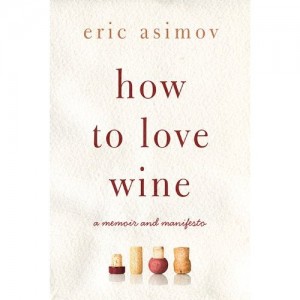“Does the world really need another book about wine?”
There are stacks and stacks of books out there that cover every aspect of wine: from travel books illustrating which wineries you should visit in a particular wine region to books that teach you how to taste wine and how to pair wine with food. Eric’ Asimov’s new book; How to Love Wine: A Memoir and Manifesto; adds to the library of wine books by putting “wine anxiety” on the table, in an attempt to calm the fears and anxiety many Americans face when approached with the subject of wine.
Asimov attributes this “wine anxiety” with the pressure that is put upon consumers to be adept enough to “demystify” wine and to be able to identify the flavors and aroma or the wine, as well as the exact grape, producer, or vintage. This puts huge pressure on the average consumer, and often due to the potential embarrassment of “getting it wrong”, many consumers avoid wine altogether.
“I believe that everybody who really likes wine at one time or another feels uncertain about it…It only becomes a problem if we imagine that our uncertainty is somehow isolated, and that if we really understood wine we’d always feel confident and assured, the way wine authorities are supposed to feel. Me? I feel confident in my uncertainty.”
Asimov addresses the issue of wine anxiety in an almost autobiographical manner. He steps back and approaches the problems with how many Americans are intimidated by wine by telling the his own personal story about how he fell in love with wine and how his love of wine evolved over time before eventually landing his current position as the Chief Wine Critic of the New York Times.
Asimov’s stories are written in a very down-to-earth style, and provide the readers with the assurance that even he, the expert, is at times stumped by wine and yet is perfectly content to let that happen. His stories provide the beginner wine consumer with the assurance that there doesn’t need to be this absolutely mastery of everything wine, and that wine is a forever-hobby: there is always something to learn, and you should never feel inadequate for not knowing one particular fact over another.
“In the end…scores are a poor substitute for wisdom, a conclusion that, alas, offers two potentially unsatisfying alternatives. On the one hand, you can continue to trust in scores, knowing you may miss out on many highly satisfying wines that are not the type that earn high scores. On the other, you can begin the quest for understanding, which consists simply of thought and judgment applied to experience.”
Asimov, while understanding that he may make some people annoyed or even angry at his statements, tears apart the concept of the “tyranny of the tasting note”; a concept which illustrates how many tasting notes are “over specific”, “pernicious”, and a “waste of time”. Though he understands that tasting notes may be necessary, they often are a source of fear and anxiety in beginner wine consumers who are worried or frustrated if they cannot taste what the notes claim the flavors in the wine to be.
Asimov also takes a stand against wine scores, which he describes as not giving enough information to the consumer and sometimes misleading to the consumer when a particular wine didn’t happen to be scored. If the wine was not scored, or if the wine was giving a relatively low score, does it mean it’s a bad wine? Asimov would say not necessarily—it all depends on who tastes the wine and their specific flavor preferences, and the context in which the wine is being consumed. Is the consumer having a glass of wine with food by themselves or perhaps at a dinner party with friends and family? According to Asimov, context is critical, and thus the scores which were based on tasting hundreds of wines all at once without food by one individual effectively mean nothing to the consumer purchasing the bottle of wine.
“Wine is not an easy subject to master, and anybody who insists otherwise is after your hard-earned money. Luckily, mastery is not the goal; ease is what we’re after.”
Overall, I enjoyed How to Love Wine: A Memoir and Manifesto by Eric Asimov immensely. It was very well written, and has huge entertainment value to anyone reading. It provides a semi-autobiographical sketch of one man’s quest for wine knowledge, and assures the beginner that they shouldn’t feel anxiety or stress about wine. Toward the end of the book, Asimov provides an excellent “how to learn wine” rubric for those seeking to learn more about wine, and provides comfort to those that may be hesitant about embarking on the journey.
Whether you are a beginner or a seasoned professional, this book is a wonderful addition to your wine book collection, and I highly recommend it for anyone who is even remotely interested in the mysterious joy that is wine.


